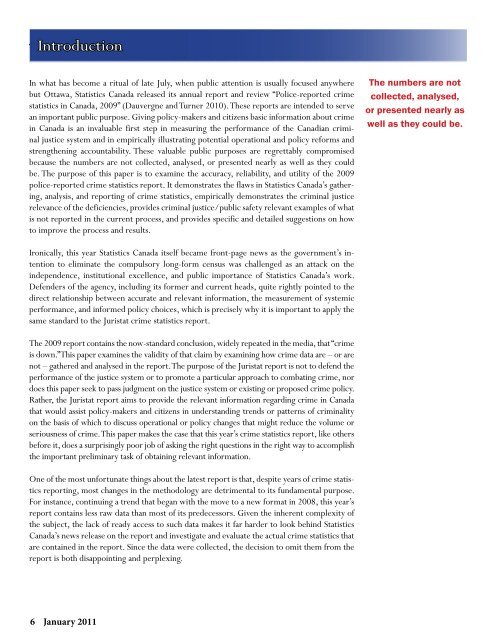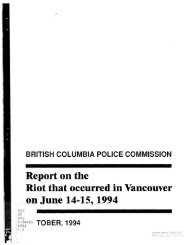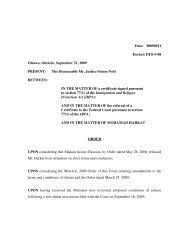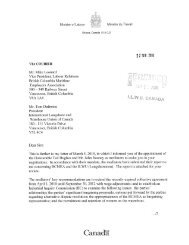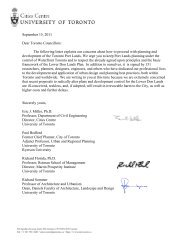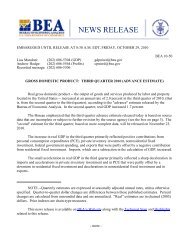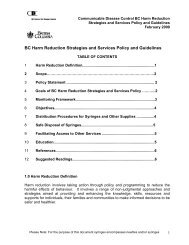Why Canadian crime statistics don't add up - The Globe and Mail
Why Canadian crime statistics don't add up - The Globe and Mail
Why Canadian crime statistics don't add up - The Globe and Mail
You also want an ePaper? Increase the reach of your titles
YUMPU automatically turns print PDFs into web optimized ePapers that Google loves.
title Introduction<br />
In what has become a ritual of late July, when public attention is usually focused anywhere<br />
but Ottawa, Statistics Canada released its annual report <strong>and</strong> review “Police-reported <strong>crime</strong><br />
<strong>statistics</strong> in Canada, 2009” (Dauvergne <strong>and</strong> Turner 2010). <strong>The</strong>se reports are intended to serve<br />
an important public purpose. Giving policy-makers <strong>and</strong> citizens basic information about <strong>crime</strong><br />
in Canada is an invaluable first step in measuring the performance of the <strong>Canadian</strong> criminal<br />
justice system <strong>and</strong> in empirically illustrating potential operational <strong>and</strong> policy reforms <strong>and</strong><br />
strengthening accountability. <strong>The</strong>se valuable public purposes are regrettably compromised<br />
because the numbers are not collected, analysed, or presented nearly as well as they could<br />
be. <strong>The</strong> purpose of this paper is to examine the accuracy, reliability, <strong>and</strong> utility of the 2009<br />
police-reported <strong>crime</strong> <strong>statistics</strong> report. It demonstrates the flaws in Statistics Canada’s gathering,<br />
analysis, <strong>and</strong> reporting of <strong>crime</strong> <strong>statistics</strong>, empirically demonstrates the criminal justice<br />
relevance of the deficiencies, provides criminal justice/public safety relevant examples of what<br />
is not reported in the current process, <strong>and</strong> provides specific <strong>and</strong> detailed suggestions on how<br />
to improve the process <strong>and</strong> results.<br />
<strong>The</strong> numbers are not<br />
collected, analysed,<br />
or presented nearly as<br />
well as they could be.<br />
Ironically, this year Statistics Canada itself became front-page news as the government’s intention<br />
to eliminate the compulsory long-form census was challenged as an attack on the<br />
independence, institutional excellence, <strong>and</strong> public importance of Statistics Canada’s work.<br />
Defenders of the agency, including its former <strong>and</strong> current heads, quite rightly pointed to the<br />
direct relationship between accurate <strong>and</strong> relevant information, the measurement of systemic<br />
performance, <strong>and</strong> informed policy choices, which is precisely why it is important to apply the<br />
same st<strong>and</strong>ard to the Juristat <strong>crime</strong> <strong>statistics</strong> report.<br />
<strong>The</strong> 2009 report contains the now-st<strong>and</strong>ard conclusion, widely repeated in the media, that “<strong>crime</strong><br />
is down.” This paper examines the validity of that claim by examining how <strong>crime</strong> data are – or are<br />
not – gathered <strong>and</strong> analysed in the report. <strong>The</strong> purpose of the Juristat report is not to defend the<br />
performance of the justice system or to promote a particular approach to combating <strong>crime</strong>, nor<br />
does this paper seek to pass judgment on the justice system or existing or proposed <strong>crime</strong> policy.<br />
Rather, the Juristat report aims to provide the relevant information regarding <strong>crime</strong> in Canada<br />
that would assist policy-makers <strong>and</strong> citizens in underst<strong>and</strong>ing trends or patterns of criminality<br />
on the basis of which to discuss operational or policy changes that might reduce the volume or<br />
seriousness of <strong>crime</strong>. This paper makes the case that this year’s <strong>crime</strong> <strong>statistics</strong> report, like others<br />
before it, does a surprisingly poor job of asking the right questions in the right way to accomplish<br />
the important preliminary task of obtaining relevant information.<br />
One of the most unfortunate things about the latest report is that, despite years of <strong>crime</strong> <strong>statistics</strong><br />
reporting, most changes in the methodology are detrimental to its fundamental purpose.<br />
For instance, continuing a trend that began with the move to a new format in 2008, this year’s<br />
report contains less raw data than most of its predecessors. Given the inherent complexity of<br />
the subject, the lack of ready access to such data makes it far harder to look behind Statistics<br />
Canada’s news release on the report <strong>and</strong> investigate <strong>and</strong> evaluate the actual <strong>crime</strong> <strong>statistics</strong> that<br />
are contained in the report. Since the data were collected, the decision to omit them from the<br />
report is both disappointing <strong>and</strong> perplexing.<br />
6 January 2011


